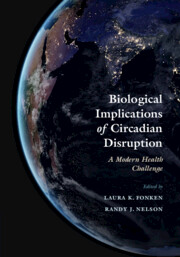Book contents
- Biological Implications of Circadian Disruption
- Biological Implications of Circadian Disruption
- Copyright page
- Contents
- Contributors
- Preface
- 1 Introduction to Circadian Rhythms
- 2 Central Clock Dynamics
- 3 Melatonin, Light, and the Circadian System
- 4 Disrupted Circadian Rhythms, Stress, and Allostatic Load
- 5 Disrupted Circadian Rhythms and Mental Health
- 6 Circadian Rhythms and Cognitive Functioning
- 7 Circadian Rhythm Disruption in Aging and Alzheimer’s Disease
- 8 Circadian Rhythms Regulate Neuroinflammation after Traumatic Brain Injury and Spinal Cord Injury
- 9 Disrupted Circadian Rhythms and Neuroendocrine Function in Fertility
- 10 Disrupted Circadian Rhythms and Metabolic Function
- 11 Disrupted Circadian Rhythms, Time Restricted Feeding, and Blood Pressure Regulation
- 12 Disrupted Circadian Rhythms and Immune Function
- 13 Circadian Rhythms and Cardiac Function
- 14 Disrupted Circadian Rhythms and Cancer
- 15 Light Effects across Species in Nature
- 16 Measurement and Analysis of Exposure to Light at Night in Epidemiology
- Index
- References
6 - Circadian Rhythms and Cognitive Functioning
Published online by Cambridge University Press: 07 October 2023
- Biological Implications of Circadian Disruption
- Biological Implications of Circadian Disruption
- Copyright page
- Contents
- Contributors
- Preface
- 1 Introduction to Circadian Rhythms
- 2 Central Clock Dynamics
- 3 Melatonin, Light, and the Circadian System
- 4 Disrupted Circadian Rhythms, Stress, and Allostatic Load
- 5 Disrupted Circadian Rhythms and Mental Health
- 6 Circadian Rhythms and Cognitive Functioning
- 7 Circadian Rhythm Disruption in Aging and Alzheimer’s Disease
- 8 Circadian Rhythms Regulate Neuroinflammation after Traumatic Brain Injury and Spinal Cord Injury
- 9 Disrupted Circadian Rhythms and Neuroendocrine Function in Fertility
- 10 Disrupted Circadian Rhythms and Metabolic Function
- 11 Disrupted Circadian Rhythms, Time Restricted Feeding, and Blood Pressure Regulation
- 12 Disrupted Circadian Rhythms and Immune Function
- 13 Circadian Rhythms and Cardiac Function
- 14 Disrupted Circadian Rhythms and Cancer
- 15 Light Effects across Species in Nature
- 16 Measurement and Analysis of Exposure to Light at Night in Epidemiology
- Index
- References
Summary
The circadian timing system has pronounced effects on learning and memory, with learning and recall regulated by time of day and the cellular mechanisms underlying learning and memory being under circadian control. Given this influence of the circadian system, studies across species, including humans, reveal that circadian disruption has pronounced negative effects on cognitive functioning. Circadian disruption leads to deficits in learning and memory by negatively affecting neurogenesis, synaptic plasticity, and epigenetic events required for acquisition and recall of memories. The present chapter describes the impact of circadian disruption on learning and memory while considering the mechanisms underlying circadian control of cognitive function. Given that the modern world is rife with temporal disruptions due to work requirements, limited exposure to sunlight during the day, and exposure to artificial lighting and blue light-emitting electronic devices at night, understanding the negative impact of circadian disruption on learning and memory and developing mitigating strategies are vital.
- Type
- Chapter
- Information
- Biological Implications of Circadian DisruptionA Modern Health Challenge, pp. 134 - 164Publisher: Cambridge University PressPrint publication year: 2023

